Press Releases
Euroseas Ltd. Reports Results for the Six-Month Period and Quarter Ended June 30, 2011
Maroussi, Athens, Greece - August 10, 2011 - Euroseas Ltd. (NASDAQ: ESEA), an owner and operator of drybulk and container carrier vessels and provider of seaborne transportation for drybulk and containerized cargoes, announced today its results for the three and six month periods ended June 30, 2011.
Second Quarter 2011 Highlights:
-Net income of $0.03 million or $0.00 earnings per share basic and diluted on total net revenues of $15.6 million. Excluding the effect of unrealized and realized loss on derivatives and unrealized loss on trading securities and amortization of the fair value of charters acquired, the net earnings per share for the period would have remained unchanged.
-Adjusted EBITDA was $5.0 million. Please refer to a subsequent section of the Press Release for a reconciliation of adjusted EBITDA to net income.
-An average of 16.00 vessels were owned and operated during the second quarter of 2011 earning an average time charter equivalent rate of $11,302 per day.
-Declared a quarterly dividend of $0.07 per share for the second quarter of 2011 payable on or about September 9, 2011 to shareholders of record on September 2, 2011. This is the twenty-fourth consecutive quarterly dividend declared.
First Half 2011 Highlights:
-Net loss of $0.6 million or $0.02 loss per share basic and diluted on total net revenues of $29.8 million. Excluding the effect of unrealized and realized loss on derivatives and unrealized loss on trading securities and amortization of the fair value of charters acquired, the net loss for the period would have been $1.3 million, or $0.04 loss per share basic and diluted
-Adjusted EBITDA was $8.7 million. Please refer to a subsequent section of the Press Release for a reconciliation of adjusted EBITDA to net loss.
-An average of 16.00 vessels were owned and operated during the first half of 2011 earning an average time charter equivalent rate of $11,198 per day.
-Declared two quarterly dividends for a total of $0.14 per share during the first half of 2011.
Aristides Pittas, Chairman and CEO of Euroseas commented: "During the first half of 2011, the containership market recovery continued and allowed us to renew the expiring charters of our containership fleet at significantly higher rates. The strengthening of the market compared to a year ago also allowed us to reactivate and profitably employ two of our containerships which were laid up during the same period of 2010. In parallel, our strategy to fully charter out our drybulk fleet for 2011 and about 70% for 2012 has insulated us from the weakness of the drybulk market.
On the investment front, while we continue to pursue investments in the containership sector through our Euromar joint venture, which recently agreed to acquire its seventh vessel, we have been also reviewing opportunities in the drybulk sector, in which we expect the weakness in rates to translate into lower vessel prices.
We remain optimistic about the prospects of Euroseas as we believe our conservative strategy has provided us with a strong balance sheet and has positioned us well to take advantage of opportunities as they might emerge. Our Board decided to re-affirm our quarterly dividend to $0.07 per share which represents an annual yield of about 6.9% on the basis of our stock price on August 2, 2011."
Tasos Aslidis, Chief Financial Officer of Euroseas commented: "The results of the second quarter of 2011 reflect the strengthening of the containership market compared to the same quarter of 2010, the higher number of our vessels profitably employed but also higher interest rate swap related derivative losses due to the drop of interest rates.
Total daily vessel operating expenses, including management fees, general and administrative expenses but excluding drydocking costs, averaged $6,066 per vessel per day during the second quarter of 2011 as compared to $5,510 per vessel per day for the same quarter of last year for the vessels not in lay-up, and $6,002 per vessel per day for the first half of 2011 as compared to $5,677 per vessel per day for the same period of 2010 again for the vessels not in lay-up; the increase is partly attributed to the higher cost of lubricants and the higher dollar / euro exchange rate. As always, we want to emphasize that cost control remains a key component of our strategy.
As of June 30, 2011, our outstanding debt was $80.8 million versus restricted and unrestricted cash of about $35.4 million. As of the same date, our scheduled debt repayments over the next 12 months amounted to about $13.7 million a number low enough to provide us with significant operational cash flow comfort. All our debt covenants were satisfied as of June 30, 2011."
Second Quarter 2011 Results:
For the second quarter of 2011, the Company reported total net revenues of $15.6 million representing a 14.0% increase over total net revenues of $13.7 million during the second quarter of 2010. The Company reported net income for the period of $0.03 million as compared to income of $0.5 million for the second quarter of 2010. The results for the second quarter of 2011 include a $0.6 million net unrealized loss on derivatives and trading securities and a $0.2 million net realized loss on derivatives as compared to $3.3 million net unrealized gain on derivatives and trading securities and $3.7 million realized loss on derivatives for the same period of 2010.
Depreciation expenses for the second quarter of 2011 were $4.6 million compared to $4.4 million during the same period of 2010. On average, 16.00 vessels were owned and operated during the second quarter of 2011 earning an average time charter equivalent rate of $11,302 per day compared to 15.11 vessels in the same period of 2010 earning on average $11,903 per day.
Adjusted EBITDA for the second quarter of 2011 was $5.0 million, unchanged compared to $5.0 million achieved during the second quarter of 2010. Please see below for Adjusted EBITDA reconciliation to net income / loss and cash flow provided by operating activities.
Basic and diluted earnings per share for the second quarter of 2011 was $0.00, calculated on 31,002,711 basic and 31,116,172 diluted weighted average number of shares outstanding, compared to basic and diluted earnings per share of $0.02 for the second quarter of 2010, calculated on 30,849,711 basic and 30,940,288 diluted weighted average number of shares outstanding, respectively.
Excluding the effect on the earnings for the quarter of the unrealized loss on derivatives and the realized loss on derivatives, unrealized loss on trading securities and amortization of the fair value of time charter contracts acquired, the gain per share for the quarter ended June 30, 2011 would have been $0.00 per share basic and diluted compared to earnings of $0.02 per share for the quarter ended June 30, 2010. Usually, security analysts do not include the above items in their published estimates of earnings per share.
First Half 2011 Results:
For the first half of 2011, the Company reported total net revenues of $29.8 million representing a 8.6% increase over total net revenues of $27.5 million during the first half of 2010. The Company reported a net loss for the period of $0.6 million as compared to net loss of $2.5 million for the first half of 2010. The results for the first half of 2011 include a $0.1 million net unrealized loss on derivatives and trading securities and a $0.4 million net realized loss on derivatives as compared to a $4.0 million net unrealized gain on derivatives and trading securities and $8.4 million realized loss on derivatives for the same period of 2010.
Depreciation expenses for the first half of 2011 were $9.2 million compared to $8.8 million during the same period of 2010. On average, 16.00 vessels were owned and operated during the first half of 2011 earning an average time charter equivalent rate of $11,198 per day compared to 15.06 vessels in the same period of 2010 earning on average $12,152 per day.
Adjusted EBITDA for the first half of 2011 was $8.7 million, a 12.3% decrease from $10.0 million achieved during the first half of 2010. Please see below for Adjusted EBITDA reconciliation to net income/loss and cash flow provided by operating activities.
Basic and diluted loss per share for the first half of 2011 was $0.02, calculated on 31,002,711 weighted average number of shares outstanding, compared to basic and diluted loss per share of $0.08 basic and diluted per share for the first half of 2010, calculated on 30,849,711 weighted average number of shares outstanding basic and diluted.
Excluding the effect on the losses for the first half of 2011 of the unrealized loss on derivatives, realized loss on derivatives, unrealized loss on trading securities and amortization of the fair value of time charter contracts acquired, the loss per share for the six-month period ended June 30, 2011 would have been $0.04 per share basic and diluted compared to earnings of $0.03 per share basic and diluted for the same period in 2010. Usually, security analysts do not include the above items in their published estimates of earnings per share.
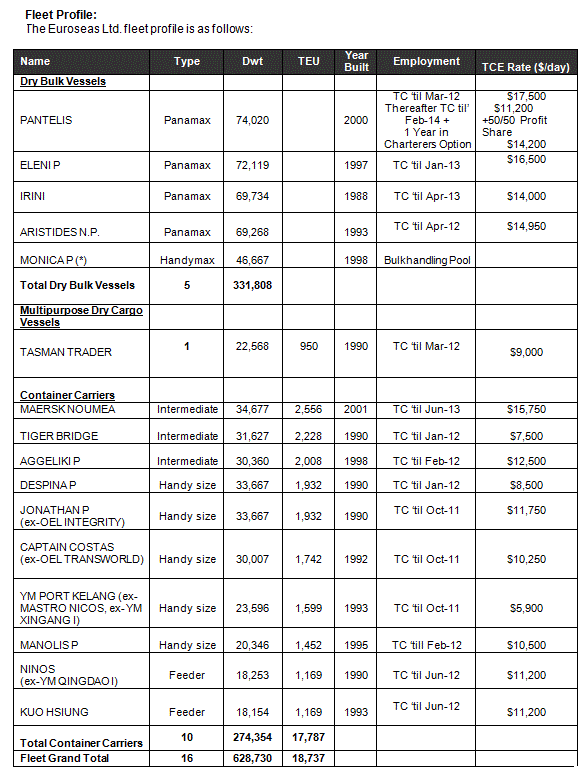
(*) "Monica P" is employed in the Bulkhandling spot pool that is managed by Klaveness.
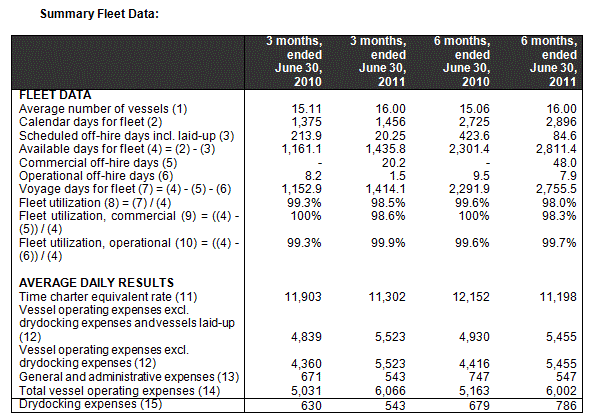
(1) Average number of vessels is the number of vessels that constituted our fleet for the relevant period, as measured by the sum of the number of calendar days each vessel was a part of our fleet during the period divided by the number of calendar days in that period.
(2) Calendar days. We define calendar days as the total number of days in a period during which each vessel in our fleet was in our possession including off-hire days associated with major repairs, drydockings or special or intermediate surveys or days of vessels in lay-up. Calendar days are an indicator of the size of our fleet over a period and affect both the amount of revenues and the amount of expenses that we record during that period.
(3) The scheduled off-hire days including vessels laid-up are days associated with scheduled repairs, drydockings or special or intermediate surveys or days of vessels in lay-up. The shipping industry uses available days to measure the number of days in a period during which vessels were available to generate revenues.
(4) Available days. We define available days as the total number of days in a period during which each vessel in our fleet was in our possession net of scheduled off-hire days including days of vessels laid-up.
(5) Commercial off-hire days. We define commercial off-hire days as days waiting to find employment.
(6) Operational off-hire days. We define operational off-hire days as days associated with unscheduled repairs or other off-hire time related to the operation of the vessels,
(7) Voyage days. We define voyage days as the total number of days in a period during which each vessel in our fleet was in our possession net of commercial and operational off-hire days. The shipping industry uses voyage days to measure the number of days in a period during which vessels actually generate revenues.
(8) Fleet utilization. We calculate fleet utilization by dividing the number of our voyage days during a period by the number of our available days during that period. The shipping industry uses fleet utilization to measure a company's efficiency in finding suitable employment for its vessels and minimizing the amount of days that its vessels are off-hire for reasons such as unscheduled repairs or days waiting to find employment.
(9) Fleet utilization, commercial. We calculate commercial fleet utilization by dividing our available days net of commercial off-hire days during a period by our available days during that period.
(10) Fleet utilization, operational. We calculate operational fleet utilization by dividing our available net of operational off-hire days during a period by our available days during that period.
(11) Time charter equivalent, or TCE, is a measure of the average daily revenue performance of a vessel on a per voyage basis. Our method of calculating TCE is consistent with industry standards and is determined by dividing revenue generated from voyage charters net of voyage expenses by voyage days for the relevant time period. Voyage expenses primarily consist of port, canal and fuel costs that are unique to a particular voyage, which would otherwise be paid by the charterer under a time charter contract, as well as commissions. TCE is a standard shipping industry performance measure used primarily to compare period-to-period changes in a shipping company's performance despite changes in the mix of charter types (i.e., spot voyage charters, time charters and bareboat charters) under which the vessels may be employed between the periods.
(12) Daily vessel operating expenses, which includes crew costs, provisions, deck and engine stores, lubricating oil, insurance, maintenance and repairs and management fees are calculated by dividing vessel operating expenses by fleet calendar days for the relevant time period. Drydocking expenses are reported separately. During the three- and six-month periods in 2010, two of the vessels were laid-up and incurred expenses on average of $1,221 and $1,061 per day each, respectively; excluding the laid-up vessels from the fleet average the vessel operating expenses were $4,839 and $4,930 per vessel per day, respectively.
(13) Daily general and administrative expense is calculated by dividing general and administrative expense by fleet calendar days for the relevant time period.
(14) Total vessel operating expenses, or TVOE, is a measure of our total expenses associated with operating our vessels. TVOE is the sum of vessel operating expenses excluding drydocking expenses and general and administrative expenses. Daily TVOE is calculated by dividing TVOE by fleet calendar days for the relevant time period.
(15) Drydocking expenses, which include expenses during drydockings that would been capitalized and amortized under the deferral method divided by the fleet calendar days for the relevant period. Drydocking expenses could vary substantially from period to period depending on how many vessels underwent drydocking during the period.
Conference Call and Webcast:
Later today, Wednesday, August 10, 2011 at 10:00 a.m. EDT, the company's management will host a conference call to discuss the results.
Conference Call details:
Participants should dial into the call 10 minutes before the scheduled time using the following numbers: 1 (866) 819-7111 (from the US), 0(800) 953-0329 (from the UK) or +(44) (0) 1452 542 301 (from outside the US). Please quote "Euroseas."
A replay of the conference call will be available until August 17, 2011. The United States replay number is 1(866) 247-4222; from the UK 0(800) 953-1533; the standard international replay number is (+44) (0) 1452 550 000 and the access code required for the replay is: 6973591#.
Audio Webcast - Slides Presentation:
There will be a live and then archived audio webcast of the conference call, via the internet through the Euroseas website (www.euroseas.gr). Participants to the live webcast should register on the website approximately 10 minutes prior to the start of the webcast.
The slide presentation on the second quarter results for the period ended June 30, 2011 will also be available in PDF format 30 minutes prior to the conference call and webcast accessible on the company's website (www.euroseas.gr) on the webcast page. Participants to the webcast can download the PDF presentation.
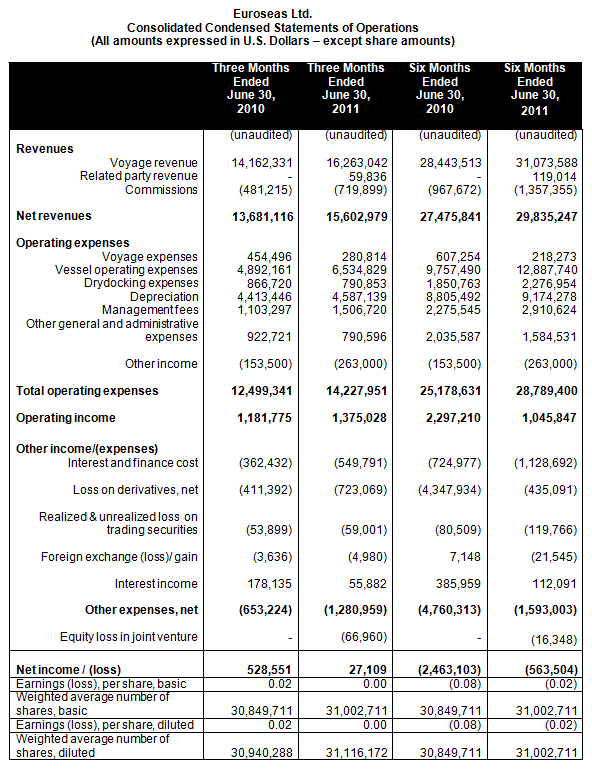
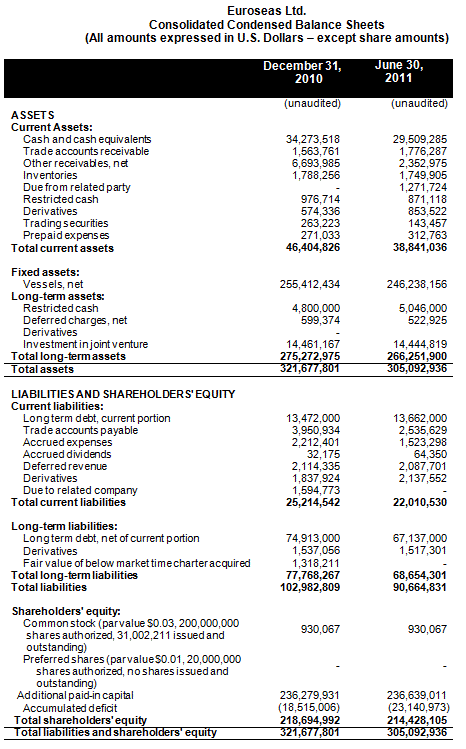
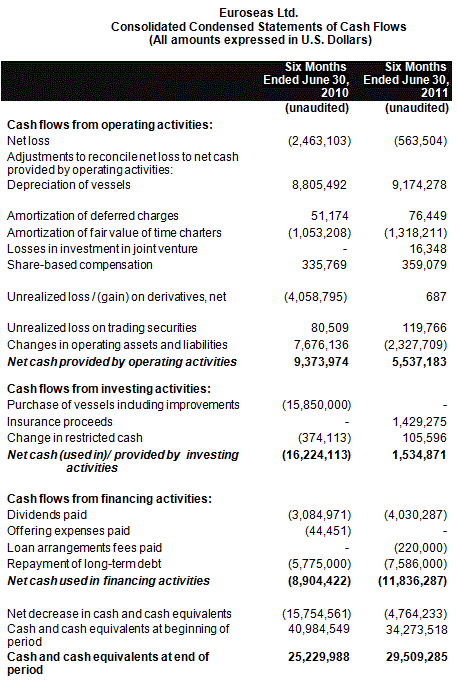
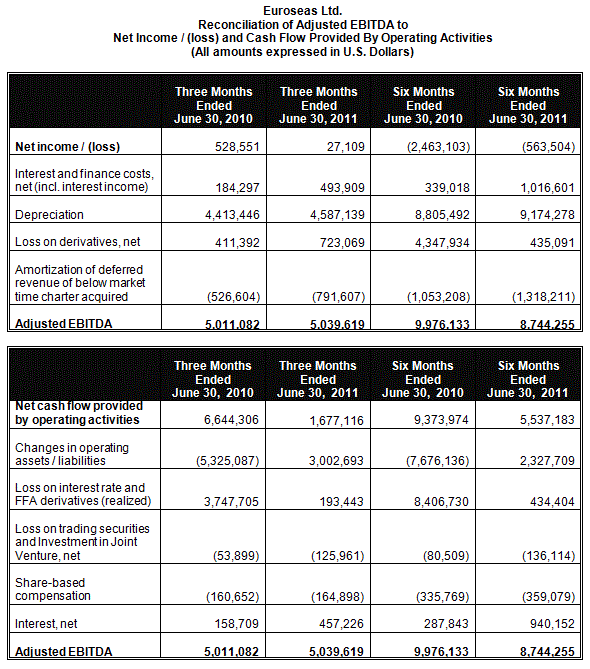
EBITDA Reconciliation:
Euroseas Ltd. considers Adjusted EBITDA to represent net earnings before interest, income taxes, depreciation, amortization, gain / loss in derivatives and amortization of deferred revenues from above or below market time charters acquired. Adjusted EBITDA does not represent and should not be considered as an alternative to net income or cash flow from operations, as determined by United States generally accepted accounting principles, or U.S. GAAP, and our calculation of Adjusted EBITDA may not be comparable to that reported by other companies. Adjusted EBITDA is included herein because it is a basis upon which we assess our financial performance and liquidity position and because we believe that it presents useful information to investors regarding a company's ability to service and/or incur indebtedness. The Company's definition of Adjusted EBITDA may not be the same as that used by other companies in the shipping or other industries.
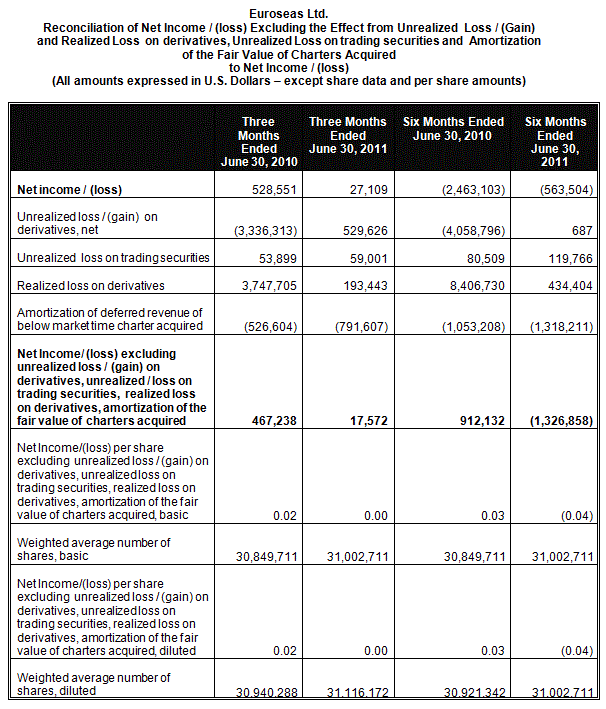
About Euroseas Ltd.
Euroseas Ltd. was formed on May 5, 2005 under the laws of the Republic of the Marshall Islands to consolidate the ship owning interests of the Pittas family of Athens, Greece, which has been in the shipping business over the past 136 years. Euroseas trades on the NASDAQ Global Market under the ticker ESEA since January 31, 2007.
Euroseas operates in the dry cargo, drybulk and container shipping markets. Euroseas' operations are managed by Eurobulk Ltd., an ISO 9001:2000 certified affiliated ship management company, which is responsible for the day-to-day commercial and technical management and operations of the vessels. Euroseas employs its vessels on spot and period charters and through pool arrangements.
The Company has a fleet of 16 vessels, including 4 Panamax drybulk carriers and 1 Handymax drybulk carrier, 3 Intermediate containership, 5 Handysize containerships, 2 Feeder containerships and a multipurpose dry cargo vessel. Euroseas` 5 drybulk carriers have a total cargo capacity of 331,808 dwt, its 10 containerships have a cargo capacity of 17,787 teu and its multipurpose vessel has a cargo capacity of 22,568 dwt or 950 teu.
Forward Looking Statement
This press release contains forward-looking statements (as defined in Section 27A of the Securities Act of 1933, as amended, and Section 21E of the Securities Exchange Act of 1934, as amended) concerning future events and the Company's growth strategy and measures to implement such strategy; including expected vessel acquisitions and entering into further time charters. Words such as "expects," "intends," "plans," "believes," "anticipates," "hopes," "estimates," and variations of such words and similar expressions are intended to identify forward-looking statements. Although the Company believes that the expectations reflected in such forward-looking statements are reasonable, no assurance can be given that such expectations will prove to have been correct. These statements involve known and unknown risks and are based upon a number of assumptions and estimates that are inherently subject to significant uncertainties and contingencies, many of which are beyond the control of the Company. Actual results may differ materially from those expressed or implied by such forward-looking statements. Factors that could cause actual results to differ materially include, but are not limited to changes in the demand for dry bulk vessels and container ships, competitive factors in the market in which the Company operates; risks associated with operations outside the United States; and other factors listed from time to time in the Company's filings with the Securities and Exchange Commission. The Company expressly disclaims any obligations or undertaking to release publicly any updates or revisions to any forward-looking statements contained herein to reflect any change in the Company's expectations with respect thereto or any change in events, conditions or circumstances on which any statement is based.
Visit our website www.euroseas.gr
Company Contact
Tasos Aslidis
Chief Financial Officer
Euroseas Ltd.
11 Canterbury Lane,
Watchung, NJ 07069
Tel. (908) 301-9091
E-mail: aha@euroseas.gr
Investor Relations / Financial Media
Nicolas Bornozis
President
Capital Link, Inc.
230 Park Avenue, Suite 1536
New York, NY 10169
Tel. (212) 661-7566
E-mail: nbornozis@capitallink.com
